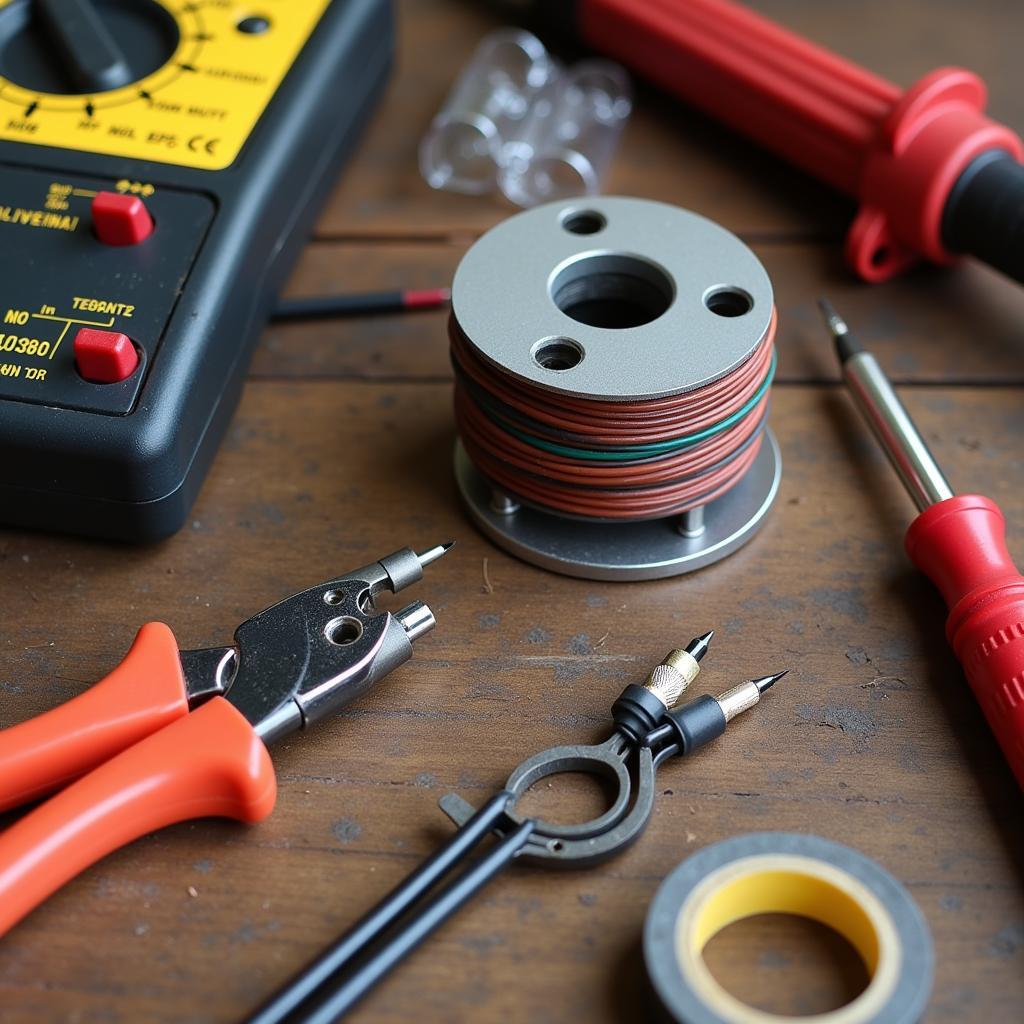Rewinding an electric fan motor can save you money and extend the life of your fan. This comprehensive guide will walk you through the process, from diagnosing the problem to testing the rewired motor. We’ll cover essential tools, safety precautions, and provide helpful tips for a successful rewind.
Understanding the Basics of Rewinding
Before diving into the rewinding process, it’s crucial to understand the basic principles involved. An electric motor works by using electromagnetic fields to create rotational force. The windings within the motor are responsible for creating these fields. When the insulation on these windings breaks down, the motor malfunctions, and rewinding becomes necessary.
Diagnosing Motor Problems
How can you tell if your fan motor needs rewinding? Several signs indicate a failing motor, such as overheating, unusual noises, slow rotation, or a complete failure to start. Checking for continuity with a multimeter can confirm if the windings are damaged.
Common Issues and Solutions
- Overheating: This can be caused by worn bearings, a jammed motor shaft, or damaged windings.
- Unusual Noises: Grinding or humming sounds often point towards bearing problems or loose components.
- Slow Rotation: This might indicate a problem with the capacitor or worn-out brushes.
 Tools for Rewinding Electric Fan Motor
Tools for Rewinding Electric Fan Motor
Gathering the Necessary Tools and Materials
Having the right tools makes the rewinding process much smoother. You’ll need a multimeter, screwdriver set, wire strippers, insulation tape, a soldering iron, and of course, the correct gauge of magnet wire for your specific motor. Choosing the proper gauge is vital for the motor’s performance and safety.
Step-by-Step Rewinding Guide
- Disassemble the Fan: Carefully take apart the fan, noting the location and connections of each component.
- Remove the Old Windings: Carefully remove the old, damaged windings, keeping track of the number of turns and the winding pattern.
- Prepare the New Windings: Cut the new magnet wire to the appropriate length, based on the old windings.
- Wind the New Coils: Wind the new coils carefully, following the original winding pattern and ensuring the turns are tight and even.
- Insulate the Windings: Apply insulation tape meticulously to each layer of the winding to prevent shorts.
- Reconnect the Windings: Solder the new windings to the motor terminals, ensuring proper connections.
- Reassemble the Fan: Put the fan back together, ensuring all components are correctly positioned and secured.
Testing the Rewound Motor
After reassembling the fan, it’s essential to test the motor before putting it back into regular use. Start by running the fan on a low setting and gradually increase the speed. Monitor the motor for any unusual noises, overheating, or vibrations.
Safety Precautions
- Always disconnect the fan from the power supply before starting any work.
- Use appropriate safety gear, such as gloves and eye protection.
- Handle the magnet wire with care to avoid cuts or punctures.
“Proper insulation is paramount when rewinding a motor,” advises John Smith, a seasoned electrical engineer with 20 years of experience. “A single missed spot can lead to a short circuit and damage the motor.”
Troubleshooting Common Rewinding Problems
Sometimes, even after rewinding, the motor might not function correctly. Common problems include incorrect winding patterns, loose connections, or inadequate insulation. Carefully double-check your work and address any issues.
Conclusion
Rewinding an electric fan motor can be a rewarding DIY project, allowing you to How To Rewind Electric Fan Motor and save money. Following the steps outlined in this guide, and taking the necessary precautions, can ensure a successful rewind and extend the life of your fan. Remember to always prioritize safety and double-check your work for optimal performance.
FAQs
- What gauge wire should I use for rewinding? The specific gauge depends on the motor’s specifications. Consult the motor’s documentation or contact the manufacturer.
- Can I rewind any type of electric motor? While many electric motors can be rewound, some are designed to be disposable and not suitable for rewinding.
- How long does a rewired motor typically last? With proper care and maintenance, a rewired motor can last for several years.
- What are the signs of a poorly rewired motor? Overheating, unusual noises, and slow rotation are indicators of a poorly rewired motor.
- Is it cheaper to rewind a motor or buy a new one? Rewinding is often cheaper than buying a new motor, especially for larger fans.
- What is the most common mistake made during rewinding? Incorrect winding patterns and inadequate insulation are common mistakes.
- How can I ensure the longevity of my rewired motor? Regular maintenance, such as lubrication and cleaning, can help extend the life of your rewired motor.
“Attention to detail is key to a successful motor rewind,” adds Maria Garcia, a veteran electrician with over 15 years of experience in motor repair. “Take your time, follow the instructions carefully, and don’t be afraid to seek professional help if needed.”
Need more help with fan motor rewinding or other electrical issues? Contact us at Phone Number: 0903426737, Email: fansbongda@gmail.com or visit us at Address: Group 9, Area 6, Gieng Day Ward, Ha Long City, Gieng Day, Ha Long, Quang Ninh, Vietnam. We have a 24/7 customer service team ready to assist you. You can also explore other helpful articles on our website related to fan repair and maintenance.


